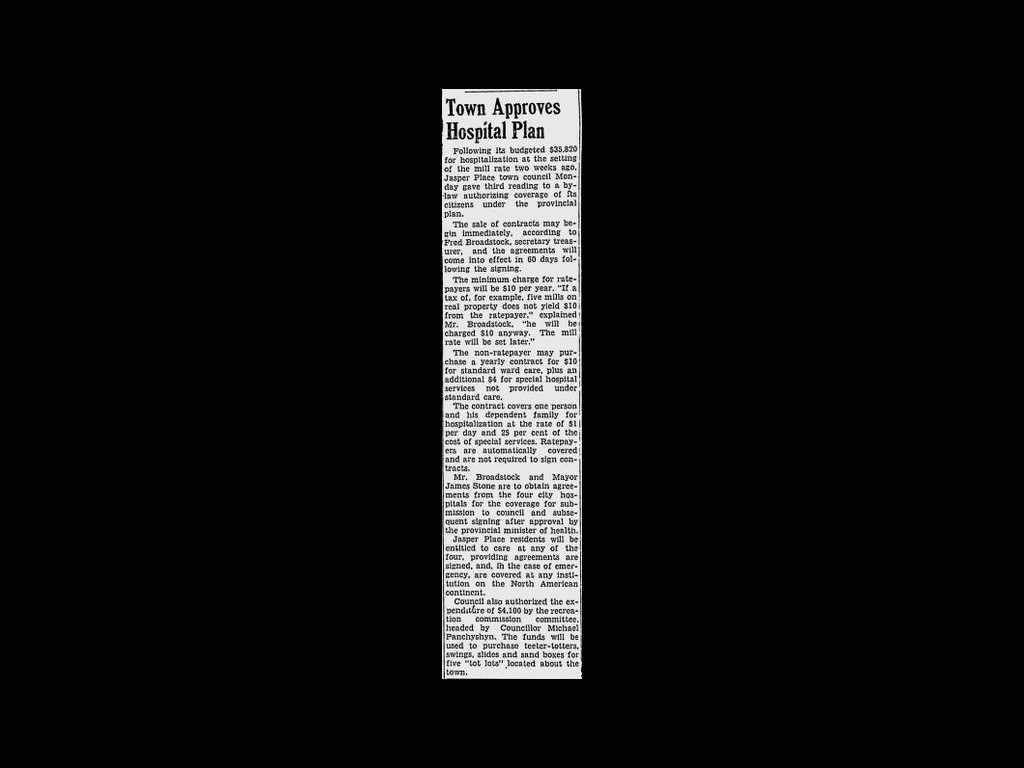On this day in 1955, the town of Jasper Place was trying to secure healthcare for its booming population.
For a place that would eventually get the nickname "The Young Giant," the town of Jasper Place had a slow start. For much of the early half of the 20th century, the area had little more than a few scattered farms that took advantage of the fertile soil to grow grain and raise livestock.
That started to change in the 1930s. Edmonton was going through a population boom, taking it from around 69,700 residents in 1928 to almost 94,000 in 1941. The growing city required more infrastructure, which was paid for through increased taxes. Jasper Place became an attractive alternative to those looking for cheaper land and lower taxes.
Soon, the town was experiencing its own boom. Centred around what is now 149th Street and Stony Plain Road, newcomers to Jasper Place built new homes at an astounding rate. The demand for building materials was so high that many families would dig out only a basement to live out the first winter before finishing the rest of the house the following year. Others would repurpose old train cars as makeshift homes.
Jasper Place and Edmonton were growing nearer to one another, although there was still enough of a distance to make travelling into the city inconvenient. As a result, people had to be largely self-sufficient. Many residences featured tiny houses on large lots, allowing people to grow much of their own food.
In 1940, Edmonton extended its trolley system to Jasper Place. Now it was possible to live in town and easily commute into the city, further fuelling the boom. The discovery of oil in Leduc in 1947 kickstarted an even bigger boom for the entire Edmonton area, and Jasper Place continued its meteoric growth. The hamlet of Jasper Place became the village of Jasper Place in 1950, with a population of 8,900. It was double that size in just two years and was incorporated as a town.
A hamlet of a few hundred has very different needs than a town of 20,000. Jasper Place needed new services to support its enlarging population. Water and sewer lines were installed in 1953, connecting to Edmonton's system. Three years later, storm sewers eliminated the need for the deep ditches dug in front of most homes to carry away rainwater. In 1960, construction started on a school and a sports complex.
By 1964, the distance between Jasper Place and Edmonton had dissolved — only a single street separated the two municipalities. Jasper Place was home to 37,429 people, making it the largest town in Canada. This unrestrained growth had taken its toll on the town's finances, leaving it heavily in debt. The town's leadership voted to amalgamate with Edmonton, and on Aug. 17, 1964, the town of Jasper Place ceased to be.
The old town's footprint now encompasses more than a dozen neighbourhoods in west Edmonton, including Lynnwood, Youngstown, and West Jasper Place, as well as many of the businesses along Stony Plain Road. While much has changed since the dizzying growth of the post-war era, the future of Jasper Place has received recent attention. The city is in the midst of a revitalization plan for the area that seeks to guide its growth for the next decade or so.
This is based on a clipping found on Vintage Edmonton, a daily look at Edmonton's history from armchair archivist @revRecluse — follow @VintageEdmonton for daily ephemera via Twitter.

